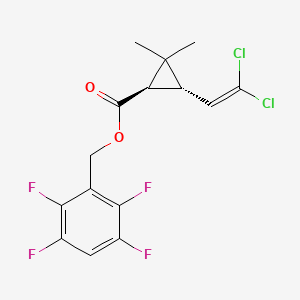D1130 | transfluthrin
| Toxicity | Dose | Time | Species | Model | Method | Action | Positive criterion | Reference |
|---|---|---|---|---|---|---|---|---|
| MEMBRANE POTENTIAL | 25.01±4.09 | human | qHTS-HepG2 | MMP assay | decrease | IC50 | 163 | |
| MEMBRANE POTENTIAL | 19.45 | human | HepG2 | MMP assay | decrease | IC50 | 163 | |
| MEMBRANE POTENTIAL | rat | hepatocytes | MMP assay | Negative | IC50 | 163 | ||
| Pictogram | Signal | Statements | Precautionary Statement Codes |
|---|---|---|---|
  |
Warning |
H315: Causes skin irritation [Warning Skin corrosion/irritation] H400: Very toxic to aquatic life [Warning Hazardous to the aquatic environment, acute hazard] H410: Very toxic to aquatic life with long lasting effects [Warning Hazardous to the aquatic environment, long-term hazard] |
P264, P273, P280, P302+P352, P321, P332+P313, P362, P391, and P501; (The corresponding statement to each P-code can be found at the GHS Classification page.) |
  |
Warning |
Aggregated GHS information provided by 206 companies from 1 notifications to the ECHA C&L Inventory. Each notification may be associated with multiple companies. H315 (100%): Causes skin irritation [Warning Skin corrosion/irritation] H400 (100%): Very toxic to aquatic life [Warning Hazardous to the aquatic environment, acute hazard] H410 (100%): Very toxic to aquatic life with long lasting effects [Warning Hazardous to the aquatic environment, long-term hazard] Information may vary between notifications depending on impurities, additives, and other factors. The percentage value in parenthesis indicates the notified classification ratio from companies that provide hazard codes. Only hazard codes with percentage values above 10% are shown. |
P264, P273, P280, P302+P352, P321, P332+P313, P362, P391, and P501; (The corresponding statement to each P-code can be found at the GHS Classification page.) |
  |
Warning |
H315: Causes skin irritation [Warning Skin corrosion/irritation] H410: Very toxic to aquatic life with long lasting effects [Warning Hazardous to the aquatic environment, long-term hazard] |
P264, P273, P280, P302+P352, P321, P332+P313, P362, P391, and P501; (The corresponding statement to each P-code can be found at the GHS Classification page.) |
| (2,3,5,6-Tetrafluorophenyl)methyl(1R,3S)-3-(2,2-dichloroethenyl)-2,2-dimethylcyclopropanecarboxylate | (2,3,5,6-tetrafluorophenyl)methyl (1R,3S)-3-(2,2-dichloroethenyl)-2,2-dimethylcyclopropane-1-carboxylate | 118712-89-3 |
| 2,3,5,6-Tetrafluorobenzyl (1R,3S)-3-(2,2-dichlorovinyl)-2,2-dimethylcyclopropane-1-carboxylate | 2,3,5,6-tetrafluorobenzyl (1R,3S)-3-(2,2-dichloroethenyl)-2,2-dimethylcyclopropanecarboxylate | 2,3,5,6-tetrafluorobenzyl (1r)-trans-3-(2,2-dichlorovinyl)-2,2-dimethylcyclopropanecarboxylate |
| 2,3,5,6-tetrafluorobenzyl trans-2-(2,2-dichlorovinyl)-3,3-dimethylcyclopropane- carboxylate; | 712T893 | AKOS015899270 |
| C13410 | CAS-118712-89-3 | CHEBI:32253 |
| CHEMBL3184657 | CS-0110699 | Cyclopropanecarboxylic acid, 3-(2,2-dichloroethenyl)-2,2-dimethyl-, (2,3,5,6-tetrafluorophenyl)methyl ester, (1R,3S)- |
| D01932 | DB15117 | DDVNRFNDOPPVQJ-HQJQHLMTSA-N |
| DSSTox_CID_26812 | DSSTox_GSID_46812 | DSSTox_RID_81924 |
| DTXSID4046812 | K-1327 | NCGC00181025-01 |
| Q418421 | QWL3SKA6EG | SCHEMBL26844 |
| Tox21_112675 | Transfluthrin | Transfluthrin (JAN) |
| Transfluthrin 10 microg/mL in Cyclohexane | Transfluthrin [ISO] | Transfluthrin, PESTANAL(R), analytical standard |
| UNII-QWL3SKA6EG | ZINC5455493 |

